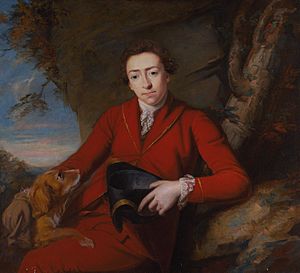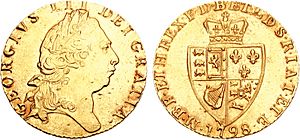John Lade facts for kids
Sir John Lade, 2nd Baronet (born August 1, 1759 – died February 10, 1838), was a well-known person in Regency society. He was famous for owning and breeding racehorses and for being a very skilled driver. He was also a close friend of King George IV when George was still a prince.
Early Life and Family
Sir John Lade was born after his father, Sir John Lade, 1st Baronet, had passed away. His family had a large fortune from brewing beer. His uncle, Henry Thrale, was also a brewer.
The famous writer Samuel Johnson was asked for advice on how to raise young John. Johnson didn't think John was very smart. He once told John's mother, "Try to help him learn things, Madam. Being rich but ignorant is like a sick sheep with too much fat – it just attracts trouble."
When Sir John turned 21, he gained control of his large family fortune.
A Life in Society

Sir John Lade enjoyed horse racing and gambling, which sometimes caused him to lose money. However, he became known as an excellent judge of horses. He owned a famous grey horse named Medley, which was one of the first thoroughbreds brought to America. Medley was considered a very important horse of his time. Sir John's unique "harlequin" racing colours were often seen at races across Britain. His horse, Crop, even finished second in the 1781 Epsom Derby.
Sir John spent a lot of time with horses and at race meetings. He often wore riding clothes, complete with many capes and a whip. He wanted to look and talk like a horse groom.
He was nicknamed "Jehu" because he was such a good driver. Sir John was a key member and a founder of the "Four-Horse Club," also known as the Four in Hand Club. His relaxed way of dressing even led to a simple knot style that the club became known for. He was famous for driving a team of six grey horses. Sometimes, he would even drive King George IV's coach, with six matched bay horses, on the road from Brighton to London.
Sir John Lade loved to make bets, not just on horses, but also on tricky skills. He once bet a thousand guineas against the Duke of Queensberry. Another time, he bet Lord Cholmondeley that he could carry him on his back around the Old Steine in Brighton. He was so skilled at driving that he once bet he could drive the wheels of his phaeton carriage over a sixpence coin. He even successfully drove a four-horse team around the tight space of Tattersall's Yard.
Letitia Lade
Sir John Lade married Letitia in 1787, after they had been together for a while. Letitia was very popular with the Prince Regent and his friends. She enjoyed the lively social scene they were known for. She was also a skilled driver, just like her husband. She once made a wager on herself in a driving contest at the Newmarket races. She also bet five hundred guineas on an eight-mile race against another woman.
Letitia Lade was known for her unique style, similar to her husband's. She is featured in a famous painting by Stubbs in the Royal Collection, which was ordered by the Prince Regent. Both she and Sir John were also painted in well-known portraits by Sir Joshua Reynolds, which are now in the National Gallery.
Later Years
Sir John Lade's fortune began to shrink because of his gambling, horse racing, and other expenses. He even spent some time in a debtor's prison because of his debts. The Prince Regent helped him out by giving him a pension, which was paid under a different name to save Sir John from embarrassment.
Sir John Lade's marriage and his many debts made him somewhat unpopular with some people in high society. There are stories of people, like Lord Thurlow, refusing to dine with the Prince Regent if Sir John was present, saying the Prince needed to "keep better company."
As their money ran out, the Lades became less active in the social scene. Letitia passed away in 1825. Sir John continued to receive his pension and lived quietly on his stud farm. Even Queen Victoria, when she was a young queen, noted in her diaries that she was paying a pension to "a Sir John Lade, one of George IV.'s intimates."
In Literature
When Sir John Lade turned 21, Samuel Johnson wrote a poem about it called "One-and-twenty." The poem begins:
Long-expected one-and-twenty
Ling'ring year, at length is flown
Pride and pleasure, pomp and plenty
Great Sir John, are now your own.
Loosen'd from the minor's tether,
Free to mortgage or to sell.
Wild as wind, and light as feather
Bid the sons of thrift farewell.....
Lavish of your grandsire's guineas
Show the spirit of an heir.
This poem later influenced A. E. Housman's famous work, A Shropshire Lad.
Sir John Lade also appears in books. In Arthur Conan Doyle's novel Rodney Stone, Sir John Lade is a leader of the "Corinthian" group of gentlemen sportsmen. He helps show the exciting London life that the main character experiences. Letitia Lade was also a main character in George William MacArthur Reynolds's Mysteries of the Court of London in 1864. She is also a smaller character in several of the Regency novels written by Georgette Heyer.


